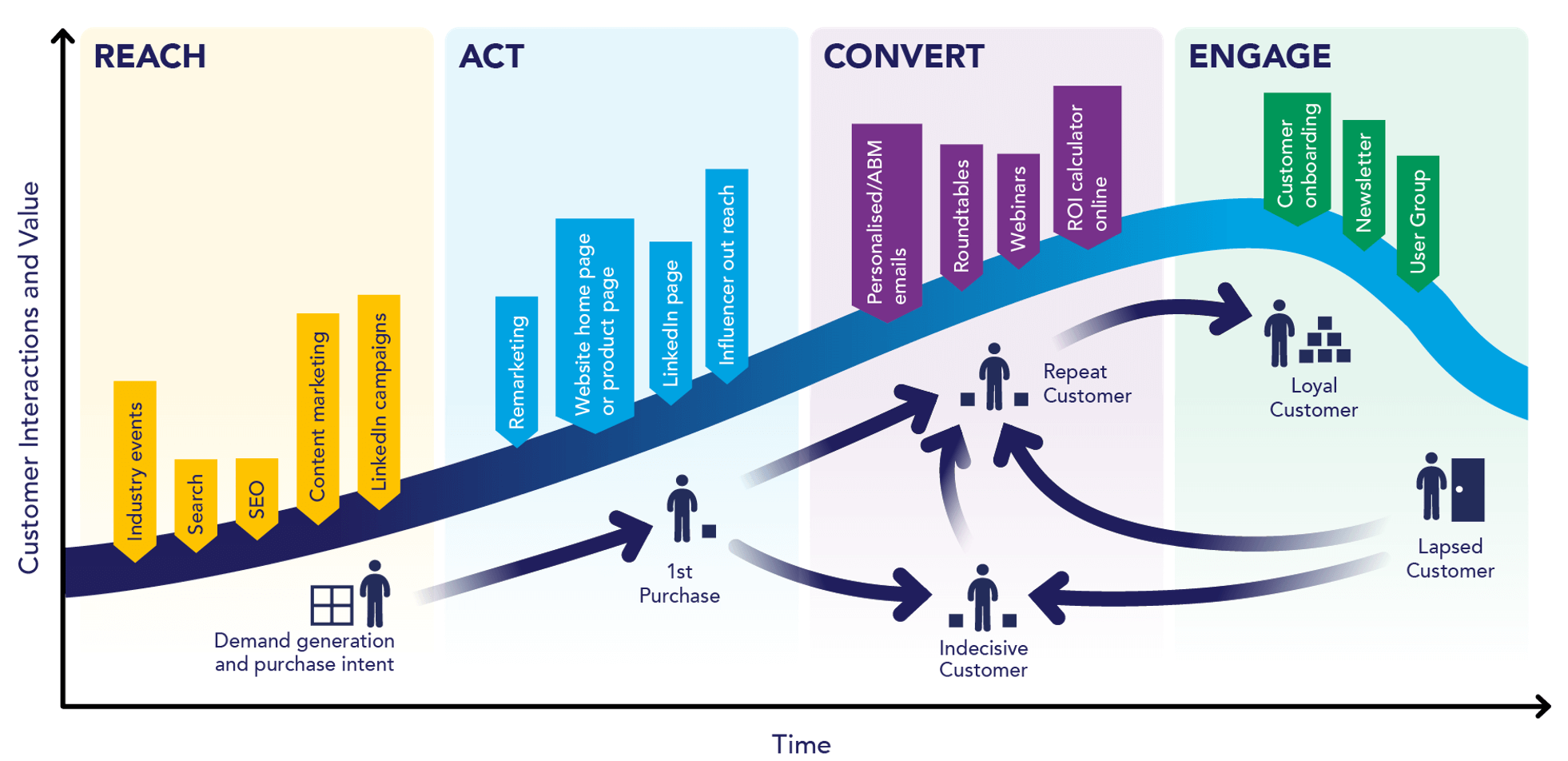Our GTM plan template structured using RACE designed for small businesses and startups
You may have heard people talking about their ‘Go To Market Strategy’ and wondered how this type of plan differs from other classical types of marketing plans. In this article, I’ll explain the purpose of a Go To Market plan and how to structure it using our RACE planning system using our template download and example.

A plan defining your Go-To-Market (GTM) Strategy is distinct from other types of business plans because its focus and scope is centred on product launches and introducing products into new markets. In larger businesses, GTM plans are often owned by Product Managers together with marketing managers. In small businesses, it will often be the co-founder, owner or a marketer who creates the GTM plan for investors. Our simple template will suit these type of people creating plans in smaller businesses.
I define a Go-To-Market plan as:
“A GTM plan is aimed at gaining customer acquisition for a new or revised service product or service to the market. It focuses on strategies to achieve market entry for branding and proposition, audience targeting and communications channels including partners”.
What does this involve in practice? Well, it can be quite complex... Here is an example of a GTM partner marketing process for a large organization defined by the agency - Coterie - that develops GTM plans for larger businesses.,

How should a GTM Strategy be structured?
As a minimum, the GTM Strategy plan should have sections covering:
- Goals and Objectives - This section defines what the company aims to achieve with the new product, such as market share, revenue targets, or customer acquisition goals. It sets specific, measurable objectives that guide the overall strategy and provide benchmarks for success.
- Product Proposition - Details the unique value or benefit of the product, explaining why it’s different from or better than competitors. It highlights features, advantages, and benefits that make the product appealing to consumers.
- Sales Strategy - Outlines how the product will be sold, including pricing strategy and distribution methods. It covers both direct channels (like company sales force or website) and indirect channels (like retailers or partners), ensuring wide market reach and customer accessibility.
- Branding - Focuses on developing the product’s brand identity and message. This includes the visual elements (logo, colors), tone of voice, and overall message that will be used across all marketing materials to establish a strong, recognizable brand in the market.
- Target Audience - Identifies the specific group of consumers who are most likely to buy the product. It includes demographic, psychographic, and behavioural characteristics, ensuring the product-market fit by tailoring the product and marketing efforts to meet the needs of these consumers.
- Campaign Launch Plan - Details the tactics and timeline for introducing the product to the market. This includes marketing and promotional activities, like social media campaigns, events, or advertising, and sets a schedule for each phase of the launch to maximize impact and reach.
How do GTM plans differ from other plans?
GTM plans tend to be more short-term and detailed compared to other sales and marketing plans. In contrast, other business plans, like strategic plans or operational plans, have broader scopes. Strategic marketing plans outline long-term business goals and directions, while operational plans focus on the day-to-day functioning of the company. The GTM plan is more specific, being primarily concerned with successfully introducing a new product or service into the market.
GTM plans include specific actions and timelines leading up to and immediately following the product launch. While this actionable focus is positive, there are some elements of the situation and marketplace analysis that can be missing. For example, it is essential to put time into reviewing competitors and how they meet customer needs and also potentially, broader PESTLE factors. Some aspects of marketing strategy may be limited. These are all covered in our Marketing Strategy template.
To give another perspective, often GTM plans have more focus on product and sales than traditional marketing and campaign plans. Writing on LinkedIn, Stanton Monlux recommends these 5 pillars of a GTM strategy:
- Product analysis - defining how demand will fit with personas
- Product messaging - defining the value proposition
- Sales proposition - defining direct sales approaches including bottom and middle of funnel content
- Marketing strategy - defining which paid, owned and earned media channels will be used to reach audiences
- Sales strategy - this includes distribution through partners
Structure of our recommended marketing plan template
This editable Word template is structured around our OSA process, of which you can see examples in different sectors in our editable Word plan templates, is structured in three parts:
- Opportunity - Situation review including marketplace analysis (customers, competitors and channel partners), performance analysis and SMART Objective setting based on forecasting (spreadsheet tools available in our templates)
- Strategy - Segmentation, Targeting and Positioning (STP) and the tactics forming the 7Ps of the marketing mix.
- Action - Budget, resourcing including team and tools and marketing technology (MarTech) and 90-day action plans.
For each of these three parts, there are 5-steps relevant for every small business.
You can download the Word template here:
Free marketing plan template download
Use our simple three-page Microsoft Word template if you work for a small business that needs to create a simple, practical marketing plan quickly. It's structured in three sections of steps using the acclaimed RACE Growth System for improving marketing results
Access the Free marketing plan template
Summary
We have seen that a Go-To-Market (GTM) Strategy is distinct from other types of business plans because its focus and scope is centred on product launches and introducing products into new markets. In larger businesses, GTM plans are often owned by Product Managers together with marketing managers. In small businesses, it will often be the co-founder, owner or a marketer who creates the GTM plan for investors. Our simple template will suit these types of people creating plans in smaller businesses.










